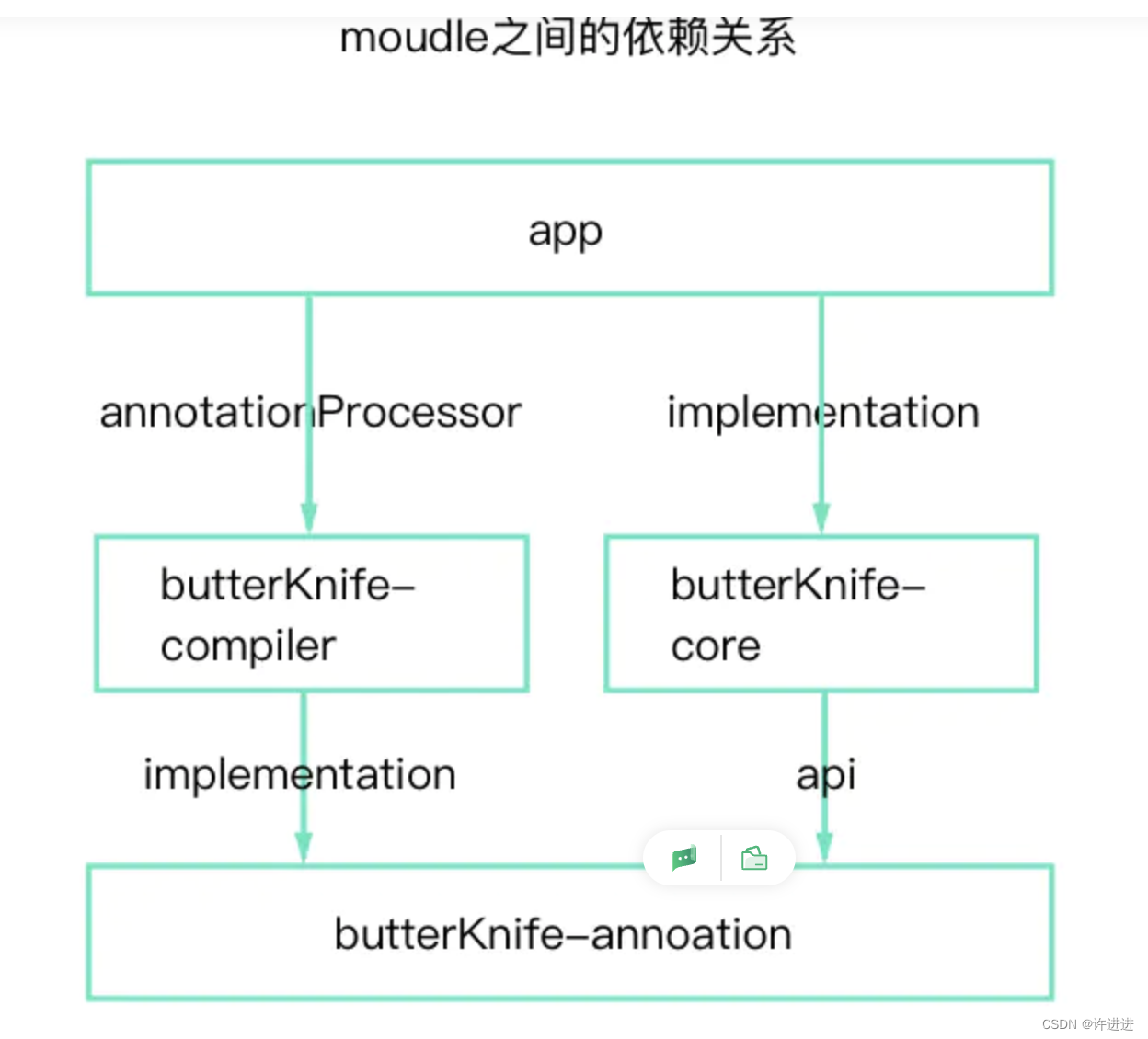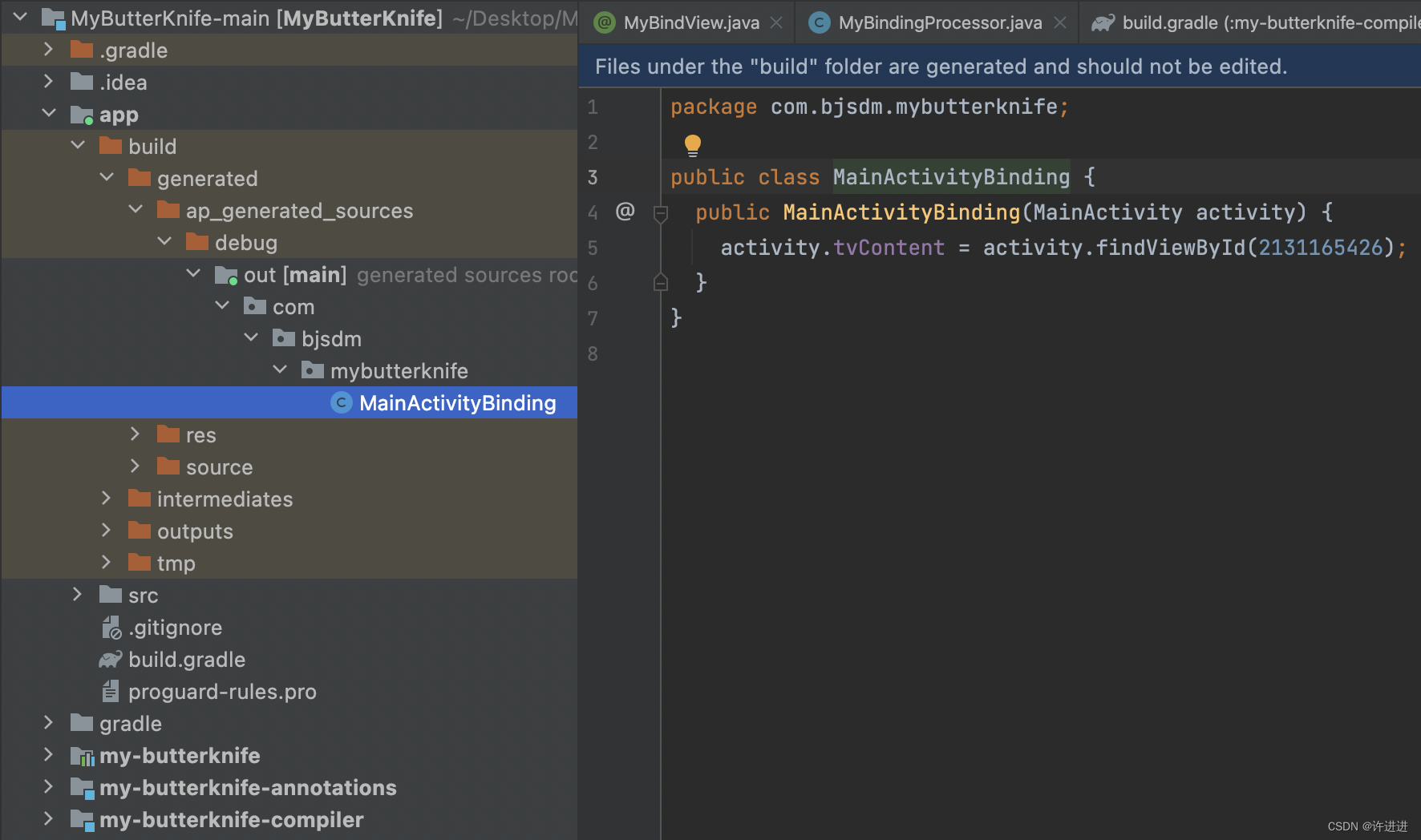前言
目的:写个简易版 ButterKnife,借手写 ButterKnife 去了解如何实现注解、annotationProcessor 的等使用。
先看下butterknife的结构:

源码地址
https://github.com/LucasXu01/MyButterKnife
ButterKnife的使用
在build.gradle添加依赖:
android {
...
// Butterknife requires Java 8.
compileOptions {
sourceCompatibility JavaVersion.VERSION_1_8
targetCompatibility JavaVersion.VERSION_1_8
}
}
dependencies {
implementation 'com.jakewharton:butterknife:10.2.3'
annotationProcessor 'com.jakewharton:butterknife-compiler:10.2.3'
}
在MainActivity中书写:
public class MainActivity extends AppCompatActivity {
@BindView(R.id.tv_content)
TextView tvContent;
@Override
protected void onCreate(Bundle savedInstanceState) {
···
ButterKnife.bind(this);
tvContent.setText("修改成功!");
}
}
分析可得,手写一个简易的ButterKnife主要分为两步:注解定义;注解解析;
手写简易ButterKnife
注解定义
新建注解MyBindView.java:
@Target(ElementType.FIELD)
@Retention(RetentionPolicy.SOURCE)
public @interface MyBindView {
int viewId();
}
`int viewId();用于绑定哪个view的 id,我们要在注解上加上变量,这样赋值过去,我们就知道为哪个 id 绑定了:
@MyBindView(viewId = R.id.tv_content)
TextView tvContent;
改进:
viewId 改为 value,假如名称为 value 的话,编译器会自动帮我们赋值,所以我们要稍微改下:
@Target(ElementType.FIELD)
@Retention(RetentionPolicy.SOURCE)
public @interface MyBindView {
int value();
}
@MyBindView(R.id.tv_content)
TextView tvContent;
注解解析
ButterKnife 是通过以下代码开始解析的:
ButterKnife.bind(this);
我们也新建个类,要在 bind() 方法里面写控件的绑定代码:
- 获取该 Activity 的全部成员变量
- 判断这个成员变量是否被 MyBindView 进行注解
- 注解符合的话,就对该成员变量进行 findViewById 赋值
public class MyButterKnife {
public static void bind(Activity activity){
//获取该 Activity 的全部成员变量
for (Field field : activity.getClass().getDeclaredFields()) {
//判断这个成员变量是否被 MyBindView 进行注解
MyBindView myBindView = field.getAnnotation(MyBindView.class);
if (myBindView != null) {
try {
//注解符合的话,就对该成员变量进行 findViewById 赋值
//相当于 field = activity.findViewById(myBindView.value())
field.set(activity, activity.findViewById(myBindView.value()));
} catch (IllegalAccessException e) {
e.printStackTrace();
}
}
}
}
}
上面的功能实现上是没有问题的,但是,每个控件的绑定都要依靠反射,这太耗性能,一个还好,但是正常的 Activity 都不止一个 View,随着 View 的增加,执行的时间越长,所以,我们必须寻找新的出路,那就是AnnotationProcessor。
最不消耗性能的方式,不就是直接使用 findViewById 去绑定 View 吗?既然如此,那么有没有什么方式能够做到在编译阶段就生成好 findViewById 这些代码,到时使用时,直接调用就行了。
我们要创建新类,这个类名有固定的形式,那就是原Activity名字+Binding:
模拟自动生成的文件:
public class MainActivityBinding {
public MainActivityBinding(MainActivity activity) {
activity.tvContent = activity.findViewById(R.id.tv_content);
}
}
修改后的 MyButterKnife:
public class MyButterKnife {
public static void bind(Activity activity) {
try {
//获取"当前的activity类名+Binding"的class对象
Class bindingClass = Class.forName(activity.getClass().getCanonicalName() + "Binding");
//获取class对象的构造方法,该构造方法的参数为当前的activity对象
Constructor constructor = bindingClass.getDeclaredConstructor(activity.getClass());
//调用构造方法
constructor.newInstance(activity);
} catch (Exception e) {
e.printStackTrace();
}
}
}
所以,我们现在只剩下一个问题了,那就是如何动态生成 MainActivityBinding 这个类了。
这时,就是真正需要用到 AnnotationProcessor。
AnnotationProcessor 是一种处理注解的工具,能够在源代码中查找出注解,并且根据注解自动生成代码。
AnnotationProcessor使用
新建一个 module。
Android Studio --> File --> New Module --> Java or Kotlin Library --> Next --> Finish 。
在新建的module中创建MyBindingProcessor 继承 AbstractProcessor,
process():里面存放着自动生成代码的代码。getSupportedAnnotationTypes():返回所支持注解类型。
@AutoService(Processor.class)
public class MyBindingProcessor extends AbstractProcessor {
@Override
public boolean process(Set<? extends TypeElement> set, RoundEnvironment roundEnvironment) {
//测试输出
System.out.println("配置成功!");
return false;
}
@Override
public Set<String> getSupportedAnnotationTypes() {
return super.getSupportedAnnotationTypes();
}
}
注意该模块添加auto-service依赖,可自动配置执行,省去传统配置META-INF文件夹的麻烦:
implementation 'com.squareup:javapoet:1.12.1'
// AS 4.3.1 -> 4.0.1 没有问题
// As-3.4.1 + gradle-5.1.1-all + auto-service:1.0-rc4
compileOnly 'com.google.auto.service:auto-service:1.0-rc4'
annotationProcessor 'com.google.auto.service:auto-service:1.0-rc4'
到这一步,配置好各个module依赖,打开 Terminal,输入./gradlew :app:compileDebugJava,查看输出有没有配置成功!,有的话,就是配置成功了!
接下来就是在MyBindingProcessor的process方法里添加具体的生成代码了:
@Override
public boolean process(Set<? extends TypeElement> set, RoundEnvironment roundEnvironment) {
//获取全部的类
for (Element element : roundEnvironment.getRootElements()) {
//获取类的包名
String packageStr = element.getEnclosingElement().toString();
//获取类的名字
String classStr = element.getSimpleName().toString();
//构建新的类的名字:原类名 + Binding
ClassName className = ClassName.get(packageStr, classStr + "Binding");
//构建新的类的构造方法
MethodSpec.Builder constructorBuilder = MethodSpec.constructorBuilder()
.addModifiers(Modifier.PUBLIC)
.addParameter(ClassName.get(packageStr, classStr), "activity");
//判断是否要生成新的类,假如该类里面 MyBindView 注解,那么就不需要新生成
boolean hasBuild = false;
//获取类的元素,例如类的成员变量、方法、内部类等
for (Element enclosedElement : element.getEnclosedElements()) {
//仅获取成员变量
if (enclosedElement.getKind() == ElementKind.FIELD) {
//判断是否被 MyBindView 注解
MyBindView bindView = enclosedElement.getAnnotation(MyBindView.class);
if (bindView != null) {
//设置需要生成类
hasBuild = true;
//在构造方法中加入代码
constructorBuilder.addStatement("activity.$N = activity.findViewById($L)",
enclosedElement.getSimpleName(), bindView.value());
}
}
}
//是否需要生成
if (hasBuild) {
try {
//构建新的类
TypeSpec builtClass = TypeSpec.classBuilder(className)
.addModifiers(Modifier.PUBLIC)
.addMethod(constructorBuilder.build())
.build();
//生成 Java 文件
JavaFile.builder(packageStr, builtClass)
.build().writeTo(filer);
} catch (IOException e) {
e.printStackTrace();
}
}
}
return false;
}
运行看看 build 目录有没有文件生成:
